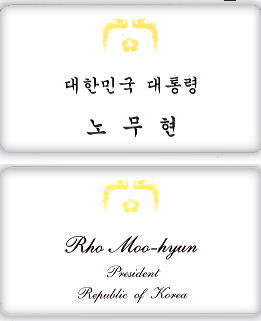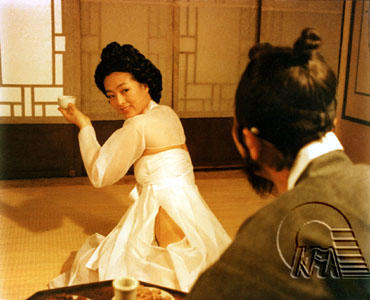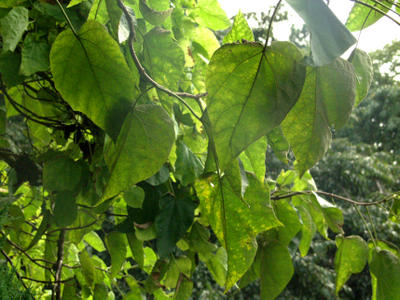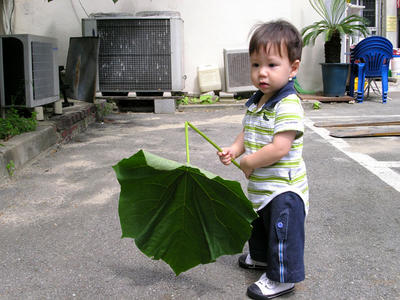山村訓長但知覓
The Sanchon Hunjang(usually clicking on the photos yields an enlarged version)
9/30/2005
I'll give you a hint, it's not 오뎅
The Sanchon Hunjang has a little quiz for you. What do you guess is the title (and hence the topic) of the following poem by 鄭谷 정곡 (849-911) of the late Tang dynasty (618-907).
What is it that gives the ants difficulty in finding their hole while making it easier for the birds to find their nests? What could the monks not care less about en masse while those of us in the mundane world get upset over just one?
Yep, that's right, the answer is falling leaves.
There are a few common symbols for autumn. On the positive side, there are blooming chrysanthemums as well as the vivid foliage of maples and ginkgos. Then there is the fact that all deciduous trees drop their leaves, which reminds people (especially those of a sentimental bent, like poets) of their mortality.
Among all those trees, the favorite example of falling leaves, at least among 한학자, is the paulownia, or 梧桐 오동. 오동, not to be confused with 우동, is fast and straight growing tree that produces pods of many seeds that were used for packing material or burned to make a premium grade of ink, while the wood was used for furniture and other carpentry projects. The paulownia was to the Chinese apparently something akin to what the buffalo was to the American Indians. Paulownia timber may not taste as good as buffalo pemmican, but they're equally tough and dry in the mouth. The paulownia, however, has an edge over the buffalo because it was believed to be the only tree where the mythical 鳳凰 봉황 (unfortunately translated as "phoenix" sometimes) would alight. This is an advantage because the 봉황 heralds the birth of a sage, thus it's use in Korea's presidential symbol:

There is a Paulownia Island at the southern port of 여수, but if you should go there in search of paulownia trees, you would come away disappointed. There is not a single 그루! They have 동백꽃, instead.
At any rate, here is what those 오동 leaves look like:

Oops...how did that get in there...um...as you can see...uh...that's 어우동, and it looks like she's already shed a leaf or two...
Let's try that again:

Ah, yes, there we go. The leaves take an elongated heart shape. I'll bet you're itching to see how poets use this tree to signal the arrival of fall. Well itch no further:
Fall came so abruptly that it surprised the paulownia tree in his garden, causing it to suddenly drop its leaves, and reminding the author that autumn is here for real (he is calculatingly ambiguous about whether it is this year's fall, or the autumn of life that upsets him so). There is no more chance to enjoy water sports.
The reason that the paulownia has become a favorite symbol for fall is that it drops its leaves at the very beginning of the season. Some commentators say that it is also because the size of the paulownia leaf is so big (in China, at least, up to a meter across!) that even one really catches your eye. As this young lad kindly demonstrates, a monstrous leaf or two falling make a good hint that autumn has really arrived.

A sidewalk strewn with leaves this size would make my hole hard to find!
返蟻難尋穴, Retiring ants have difficulty finding their hole,
歸禽易見巢. As returning birds easily see their nests.
滿廊僧不厭, Though they fill the halls, bonzes are not bothered,
一個俗嫌多. Yet even one the secular man hates as being too many.
☞ 返: 돌아올 반, 蟻: 개미 의, 難: 어려울 난, 尋: 찾을 심, 穴: 구멍 혈.
歸: 돌아갈 귀, 禽: 날짐승 금, 易: 쉬울 이, 見: 볼 견, 巢: 집(nest) 소.
滿: 찰 만, 廊: 복도 랑, 僧: 종 승, 不: 아니 불, 厭: 싫을 염.
一: 한 일, 個: 낱 개, 俗: 속될 속, 嫌: 싫어할 혐, 多: 많을 다.
What is it that gives the ants difficulty in finding their hole while making it easier for the birds to find their nests? What could the monks not care less about en masse while those of us in the mundane world get upset over just one?
Yep, that's right, the answer is falling leaves.
There are a few common symbols for autumn. On the positive side, there are blooming chrysanthemums as well as the vivid foliage of maples and ginkgos. Then there is the fact that all deciduous trees drop their leaves, which reminds people (especially those of a sentimental bent, like poets) of their mortality.
Among all those trees, the favorite example of falling leaves, at least among 한학자, is the paulownia, or 梧桐 오동. 오동, not to be confused with 우동, is fast and straight growing tree that produces pods of many seeds that were used for packing material or burned to make a premium grade of ink, while the wood was used for furniture and other carpentry projects. The paulownia was to the Chinese apparently something akin to what the buffalo was to the American Indians. Paulownia timber may not taste as good as buffalo pemmican, but they're equally tough and dry in the mouth. The paulownia, however, has an edge over the buffalo because it was believed to be the only tree where the mythical 鳳凰 봉황 (unfortunately translated as "phoenix" sometimes) would alight. This is an advantage because the 봉황 heralds the birth of a sage, thus it's use in Korea's presidential symbol:

There is a Paulownia Island at the southern port of 여수, but if you should go there in search of paulownia trees, you would come away disappointed. There is not a single 그루! They have 동백꽃, instead.
At any rate, here is what those 오동 leaves look like:

Oops...how did that get in there...um...as you can see...uh...that's 어우동, and it looks like she's already shed a leaf or two...
Let's try that again:

Ah, yes, there we go. The leaves take an elongated heart shape. I'll bet you're itching to see how poets use this tree to signal the arrival of fall. Well itch no further:
〈秋懷〉鄭鎔 (정용) "Autumn Feelings" by ChOng Yong (c. 1587)
菊垂雨中花, The chrysanthemum droops down its rain-filled flowers,
秋驚庭上梧. As autumn startles the paulownia in the garden.
今朝倍惆悵, But this morning doubles my sadness,
昨夜夢江湖. For last night I dreamt of the rivers and lakes [that I had earlier enjoyed traveling to].
☞ 秋: 가을 추, 懷: 품을 회.
菊: 국화 국, 垂: 드리울 수, 雨: 비 우, 中: 가운데 중, 花: 꽃 화.
驚: 놀랄 경, 庭: 뜰 정, 上: 위 상, 梧: 오동나무 오
今: 이제 금, 朝: 아침 조, 倍: 곱 배, 惆: 실심할 추, 悵: 슬퍼할 창창
昨: 어제 작, 夜: 밤 야, 夢: 꿈 몽, 江: 강물 강, 湖: 호수 호.
Fall came so abruptly that it surprised the paulownia tree in his garden, causing it to suddenly drop its leaves, and reminding the author that autumn is here for real (he is calculatingly ambiguous about whether it is this year's fall, or the autumn of life that upsets him so). There is no more chance to enjoy water sports.
The reason that the paulownia has become a favorite symbol for fall is that it drops its leaves at the very beginning of the season. Some commentators say that it is also because the size of the paulownia leaf is so big (in China, at least, up to a meter across!) that even one really catches your eye. As this young lad kindly demonstrates, a monstrous leaf or two falling make a good hint that autumn has really arrived.

A sidewalk strewn with leaves this size would make my hole hard to find!
Comments:
<< Home
I hesitate to call 오동도 a real island anymore since you can actually drive there on the land bridge they constructed. (돌산도 can still pull it off because the bridge crosses water).
Hello! Beautiful post...
As a Korean learner, I have a technical question. Where do you get your hanja definitions that you print out here?
thanks in advance!
hapjang
As a Korean learner, I have a technical question. Where do you get your hanja definitions that you print out here?
thanks in advance!
hapjang
Joel: I know what you mean. I recall having the same thought when I rode a bus to 월미도 in 인천 one time. I was expecting to see a real island, we rode the bus for a while and everyone told me to get off, as if I had arrived, but I was still looking for this "island."
Hapjang: Each of the major Korean portals has its own Chinese character dictionary. A quick Google turns up these:
1. http://handic.paran.com/
2. http://zonmal.dreamwiz.com/ (this one even has 전서체 and address in 한자 look-up service! Like so many other Korean sites, though, it looks like you have to be using Internet Explorer to use some of the functionality. The Sanchon Hunjang's Linux box isn't going to be supporting IE any time soon :( )
3. http://hanja.naver.com/ (includes stroke order animation)
4. http://handic.empas.com/
5. http://www.e-hanja.co.kr/
If you prefer to go straight to the deep end of the pool, cyber서당 is there with on-line lectures for all sorts of classical Chinese texts (The video 시경 series by Mr. 성백효 is highly recommended).
댓글 쓰기
Hapjang: Each of the major Korean portals has its own Chinese character dictionary. A quick Google turns up these:
1. http://handic.paran.com/
2. http://zonmal.dreamwiz.com/ (this one even has 전서체 and address in 한자 look-up service! Like so many other Korean sites, though, it looks like you have to be using Internet Explorer to use some of the functionality. The Sanchon Hunjang's Linux box isn't going to be supporting IE any time soon :( )
3. http://hanja.naver.com/ (includes stroke order animation)
4. http://handic.empas.com/
5. http://www.e-hanja.co.kr/
If you prefer to go straight to the deep end of the pool, cyber서당 is there with on-line lectures for all sorts of classical Chinese texts (The video 시경 series by Mr. 성백효 is highly recommended).
<< Home
Archives
7월 2005 8월 2005 9월 2005 10월 2005 11월 2005 12월 2005 1월 2006 2월 2006 3월 2006 7월 2006 8월 2006 10월 2006 4월 2007 5월 2007 6월 2007 7월 2007 8월 2007 9월 2007 10월 2007 11월 2007 12월 2007 1월 2008 5월 2008 8월 2008

